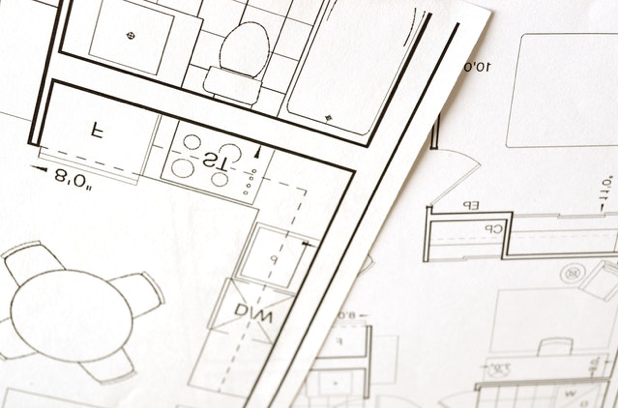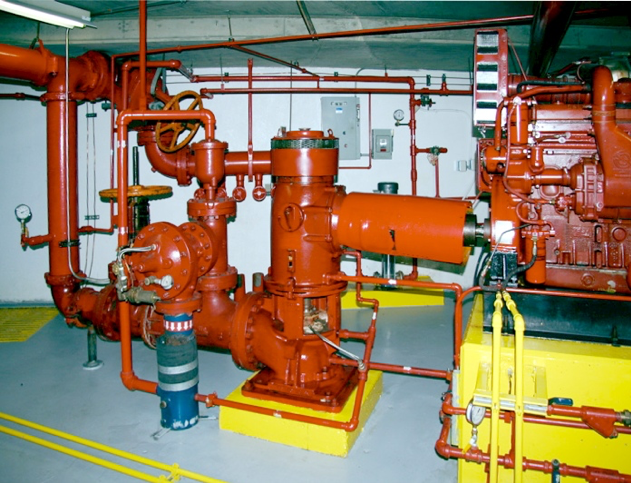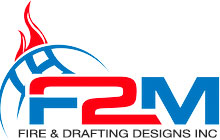Fire Pumps and Valve Rooms
Fire Pump & Valve Room Layout for Fire Sprinkler Systems
How does the fire pump & valve room layout work to serve fire sprinkler systems? How does As building codes developed over time in the US, it became vital for certain buildings to include fire sprinkler systems. However, designing and installing a modern fire sprinkler system isn’t easy and usually requires the support of qualified professionals. A professional company will generally highlight two important parts of a fire sprinkler system.

(Source)
Those two parts include the fire pump and the valve room, which has all the main controls of the fire sprinkler system. But, how does a professional fire sprinkler design company plan the layout of the room? Here are a few factors that affect the layout calculations for both components and how a professional company deals with them.
Factors Affecting Fire Pump & Valve Room Layout
The factors that affect the fire pump and valve room’s layout include:
International Building Codes and Standards
Fire sprinkler design and installation laws are governed by the international building codes and standards that also affect the residential and commercial spaces in the US. If you don’t know already, US’s primary authority on fire protection systems, National Fire Protection Association NFPA, has highlighted the rules and standards to follow for fire pump and valve room design/layout.
Location of Installation Site
One of the main factors that affect the fire pump and valve room’s layout is the location of the installation site. In simple words, the location of your residential or commercial site will significantly affect the installation of the necessary equipment.
We can take a look at this from another perspective. For instance, if you want to install a fire sprinkler system in a high-rise building, the fire pump and valve room layout calculations will primarily focus on instant access. Other factors that might influence the layout of this highly important room include:
- Climate conditions
- Topography
- Dimensions of the chosen room
- Size of the building
- Specifications of the fire sprinkler system
Maintenance Routine and Repair for the Fire Pump & Valve Room
Another great factor that influences the layout planning of the fire pump and valve room is the level of planned maintenance. For instance, your residential or commercial structure that requires a fire sprinkler system will have a maintenance routine, right? In that case, the professionals who are creating the layout to install a fire pump and choose a valve room at your site will use that information.

(Source)
It’s important to install the fire pump and valve room in a way that maintenance doesn’t become difficult. Since a fire sprinkler system will require routine care and maintenance to be functional throughout the year, the location of the room can have a huge impact.
In any case, you don’t have to use complex layout calculations and various software to install and design a fire pump and valve room. A professional company can handle all that for you while you sit back and relax.
Fire Pump & Valve Room Layout for Fire Sprinkler Systems: Conclusion
A good fire sprinkler system company will claim that it’s coming to design and install a specified fire protection system for your residential or commercial property. However, a great company will go further. To keep your property safe, whether it’s your home, office, or any other space, F2M Fire Drafting and Designs Inc. works tirelessly with the support of some of the most skilled experts.
We can plan the fire pump and valve room layout. Following that, we can move quickly to the installation phase, so you don’t have to wait a long time before having your property safe against fire hazards.
Call today for a consultation.
F2M Fire & Drafting Designs Inc.
1231 Lafayette Ave, Fl 2
Bronx, New York, 10474
Phone: (718) 928-3009
Email: info@f2mfadds.com
Fire Pumps And Valve Rooms: What Are They For?
Fire Pumps and valve rooms are an integral part of a fire sprinkler system. Once you acknowledge how a fire sprinkler system works through sprinkler heads, it’s time to know how water flows through the system. Fire pumps operate on diesel, electricity, or even steam. They provide the necessary pressure for the release of water through sprinkler heads during a fire emergency. They are a critical part and, therefore, require attention in different aspects.

(Source)
Importance of Fire Pumps
Fire pumps attach to municipal water supply sources. Or, they can also have a connection to a static source of water, such as ponds, lakes, rivers, reservoirs, gravity and water tanks, water towers, or even underground water tanks. They are necessary because as soon as water flows through the sprinkler heads, pressure starts to break.
The fire pumps, working on fuel, ensure standard pressure and, therefore, allow a consistent pressure in the flow of water. This enables pressurized water flow, which is necessary to douse the fires and prevent further spread.
How Do Fire Pumps Work?
Fire pumps have different types that contribute to fire safety services. These different types are:
- Vertical Split Case
- Horizontal Split Case
- Vertical Inline
- End Suction
- Vertical turbine
They work in connection with a jockey pump. A jockey pump maintains an artificial water pressure in the fire sprinkler system pipes. A jockey pump also prevents damage to fire pumps due to a sudden influx of water in the pipes and the sudden provision of pressure.
This implies that fire pumps do not have to keep running. A motor powers the fire pump. The fire pump creates pressure up to a significant level when more of the fire sprinklers are active, or other outlets of water supply are in use for fire emergencies.
The power of the motor operating the fire pump comes from the same municipal electricity supply that the building uses. However, as a contingency, the use of “transfer switch” has a high demand. This switch transfers the power supply of a fire pump to the emergency generator(s) in a building to keep the fire pump running throughout a fire emergency.
Valve Rooms: What are They?
Automatic fire sprinkler systems in commercial or even large residential spaces have the “control valve and drain.” They are generally in a “valve room.” However, the crucial role that they play in fire safety is worth knowing.
The valves control the different fire sprinkler systems in a building. They can isolate one system while running the others. It’s possible to use a control valve and shut down the sprinkler system when there is either a false alarm or the fire is out.
Maintaining these control valves and drains ensures safety from fires. At the same time, it prevents water damage because of an automatic fire sprinkler system.
Maintenance and Testing (NFPA)
The National Fire Protection Association (NFPA) of the US has some rules and codes to run a proper and reliable fire sprinkler system within the buildings. They ensure proper safety and the level of operation that is successful in protecting against fire hazards.
Valve rooms undergo different tests and repairs during their operations. Or, they might have early tests to ensure seamless performance.

(Source)
The main reasons why fire sprinkler systems in a building fail are due to the failure of the control valves and drains in the valve rooms. Therefore, it is necessary to perform proper tests for a “foolproof” fire safety system.
Two Types of Valves in a Valve Room
- Indicating Valves
These valves are visible to anyone and suggest some things about the fire sprinkler systems. They tell if a valve is shut or open. If a valve is closed, then the water flow is restricted beyond that part of the valve. Hence, water discharge may not occur through those pipes during a fire emergency. And spotting these valves and then turning them on becomes easy.
- Non-indicating valve
They are in a valve assembly that sticks with the water supply shafts underground.
Fire Pumps And Valve Rooms: Conclusion
New York’s F2M Fire & Drafting Designs Inc. design fire sprinkler and fire suppression systems. The experts at F2M will create a custom fire protection system for any building, and deliver up to code blueprints and schematics. they work in all 50 states in the USA.
Give them a call at (718) 928-3009 or email at info@f2mfadds.com.
